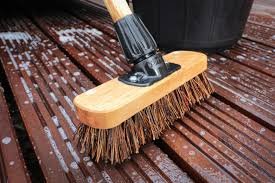Home Maintenance Tips | July 2024
Post Courtesy of Realtor.com
Scrub Decks
Prime your outdoor space for backyard barbecue blowouts by decluttering and deep-cleaning. Use a broom, leaf blower, or wet-dry vacuum to remove debris from all patio surfaces. Next, tackle the furniture.
Use a mixture of warm water and dish detergent to gently wipe down furniture cushions before leaving them out in the sun to dry. Open your patio umbrella, and use a vacuum or broom to remove any cobwebs. Wash the umbrella with soapy water and leave it open to dry. Finally, wash the patio furniture frames with soapy water, and rinse everything off with a hose.
Shortcut: To really make your deck gleam, considering renting an electric pressure washer (typically $40 per day from home improvement stores such as Home Depot and Lowe’s).
Call in the pros: You can also hire a professional power washer for $250 to $400.
2. Freshen Pool
Nothing kills your summer party game like a pool full of algae, so take a few easy steps this month to keep your water in the clear.
Shortcut: Test the pH level weekly with a pool water test kit to make sure chemicals are balanced and safe. Chemical level guidelines vary depending on the season and weather conditions, but the pH level should remain between 7.2 and 7.8 for the cleanest and safest water.
To destroy any contaminants, you’ll want to shock the water—preferably at night so the sun doesn’t burn off the chemical cocktail. Take care to never add the shock directly to your skimmer or directly to the water (which can bleach and weaken your liner). Instead, dissolve the shock in a bucket of water before adding it to your pool.
Call in the pros: If chemistry isn’t your thing, routine pool maintenance will typically set you back an average of $109 to $347 a month.
3. Inspect Windows
Poorly insulated or installed windows can sap energy from your home—and let in summer’s delightful brood of insects.
Shortcut: Check for any gaps between your windows and their casings, and inspect your screens for holes. The price for new screens vary depending on a variety of factors (including the size of your window and your geographic area), but you can plan to spend between $5 and $15 per screen.
Call in the pros: A professional can take care of this for you, but you’ll pay a premium on those hourly rates. A professional window screen replacement service will run a few hundred dollars depending on the number of windows. (You should always ask about discounts for having multiple windows done at one time.)
4. Service Washer and Dryer
In these dog days of summer, you’re probably sweating through a few more outfits than usual. (No? Just us?) If you’re buried in laundry, you’ll want to make sure your washer and dryer can handle the load. Nurture those appliances now so you aren’t schlepping to a laundromat later.
Shortcut: A bit of diluted bleach or white vinegar in the washer drum will usually take care of most cleaning needs and prevent mold from growing, according to Chris Granger, vice president and general manager of Sears Home Services.
If you have a front-loading washer, make sure to clean the gasket (that circular piece of rubber that seals the door). Use a diluted vinegar or bleach solution, and wipe behind the gasket to remove any detergent buildup or debris. Leave the door open when you’re done to allow the gasket to dry.
Finally, take it easy on detergent. “Using too much detergent can damage your washer,” Granger says. “Detergent residue can build up in the washer—and on clothes—resulting in unpleasant odors in the machine, clothes that are not completely rinsed, and, over time, machine components that can fail.”
In the dryer, remove and wash the lint screen—especially important if you use dryer sheets. And if you find that the automatic cycle isn’t fully drying your clothes, check for excess lint in the dryer vent tube.
Extra credit: If you have moisture sensors (the thin strips typically located near the dryer vent), clean them with soap and water to remove any residue, which can trick the sensors into thinking your clothes are prematurely dry.
Call in the pros: Consider calling a professional cleaning company to ensure your dryer vents are clear ($100 to $200—money well-spent to mitigate a potential fire hazard).
5. Drain Water Heater
Just like changing your car’s oil, flushing your water heater improves your unit’s efficiency and life span—and keeps your showers as scalding hot as you like them. You should drain your water heater once a year to clear out built-up sediment and minerals that could affect its performance.
Shortcut: To drain your water heater, turn off the electricity or gas to the unit, close the cold water supply valve, and affix a hose to the drain valve. Snake the hose outside and open the drain valve first, followed by the pressure relief valve. This will allow water to drain from the tank. Once the tank is empty, open the cold water valve again and let the water run clear from the hose. Close the drain and pressure relief valves, allow the tank to refill, and detach the hose. You’re now ready to turn your clean water heater back on.
Call in the pros: A professional plumber will charge between $75 and $150 to tackle this task.
6. Plant Fall Veggie Garden
This, of course, depends on your location and climate—but in general, midsummer’s a great time to plant certain fall harvest fruits and vegetables. Think basil, broccoli, cauliflower, and leafy greens such as chard, spinach, and collard greens.
Call in the pros: If you want the fruits of someone else’s labor, you can hire a professional gardener. Prices will vary, but you could expect to pay $20 to $50 an hour for a skilled gardener.




